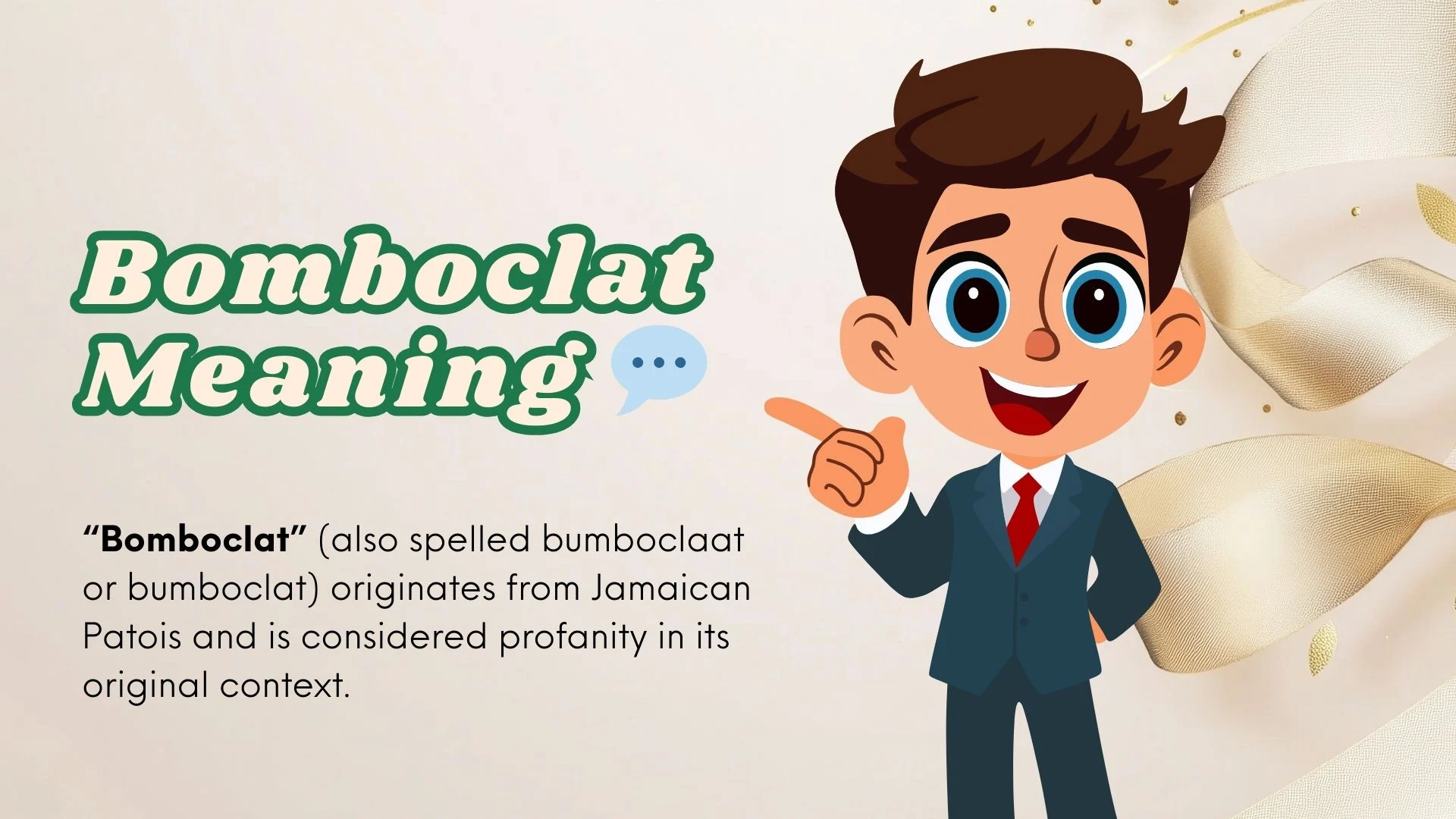Language is constantly evolving, and with the rise of social media platforms like Twitter, TikTok, and Instagram, slang terms have taken on new meanings and cultural significance.
One word that has exploded in usage and continues to raise eyebrows is “bomboclat.”
You’ve probably seen it used in memes, captions, or tweets—often without explanation.
But what does “bomboclat” really mean? Where does it come from?
How should it be used in a sentence, and are there better or more polite alternatives?
In this 2025 guide, we’re diving deep into:
- The origin, meaning, and modern usage of bomboclat
- How it’s interpreted in different contexts
- Synonyms and suitable alternatives
- Nuanced tone differences
- Examples and usage breakdown
- Plus, how to avoid inappropriate or offensive usage online and in conversation
What Does Bomboclat Mean?
“Bomboclat” (also spelled bumboclaat or bumboclat) originates from Jamaican Patois and is considered profanity in its original context.
In its native usage, the word refers to a sanitary pad or toilet paper, often used as an expression of anger, frustration, or surprise—similar to how someone might say “damn!” or “what the hell!” in English.
However, in 2019, the term took on a new life on Twitter where users began using it as a meme format.
The format followed this structure:
“Bomboclat:” [insert image or video]
It was a way of saying “caption this” or prompting a funny reaction.
Since then, bomboclat has become a global meme, with users from all over adopting it into their internet slang vocabulary.
Bomboclat Meaning In English
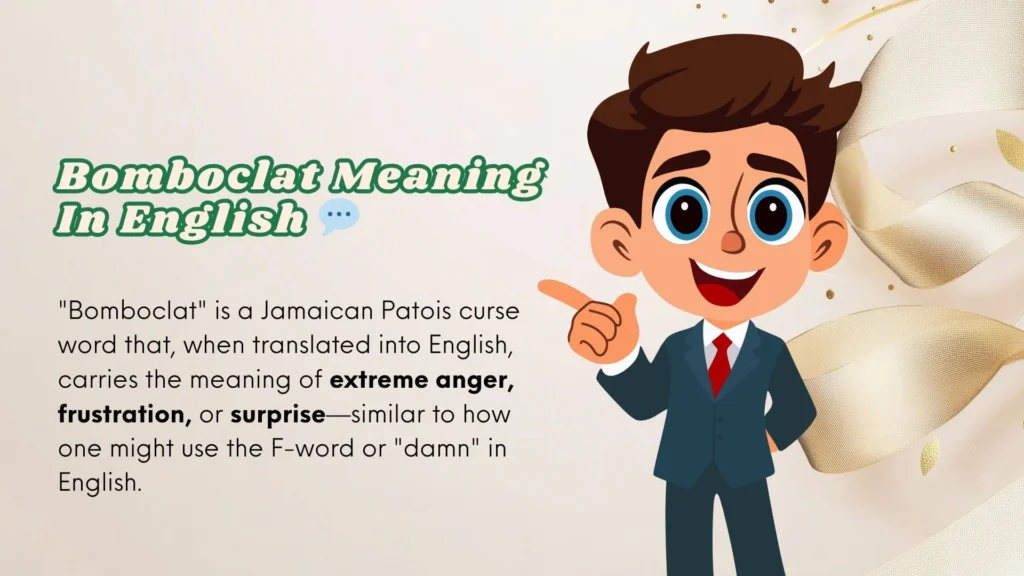
“Bomboclat” is a Jamaican Patois curse word that, when translated into English, carries the meaning of extreme anger, frustration, or surprise—similar to how one might use the F-word or “damn” in English.
While it doesn’t have a direct, polite translation, it’s often used as an expletive or to express strong emotion.
In some contexts, it may be used insultingly or aggressively, depending on the tone and intent.
Mi Bomboclat Meaning
“Mi bomboclat” translates loosely to “my damn self” or “me, damn it” in English. Here’s a breakdown:
- “Mi” means “me” or “my” in Jamaican Patois.
- “Bomboclat” is a strong expletive.
Combined, the phrase is often used to express defiance, frustration, or shock about oneself or one’s situation.
It’s not polite and should be used with caution, especially around native Jamaican speakers who understand its weight.
Bomboclat Meaning Slang
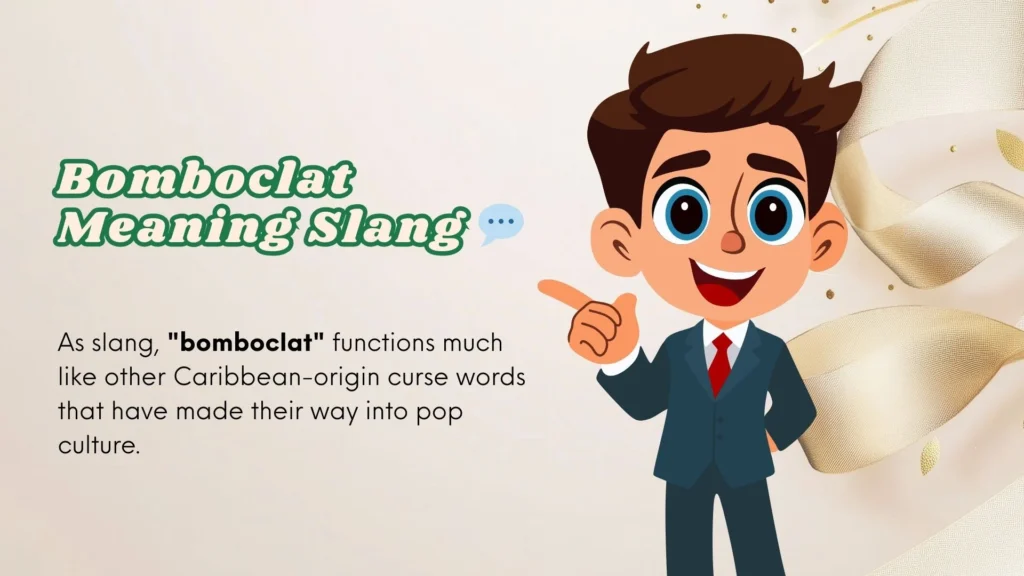
As slang, “bomboclat” functions much like other Caribbean-origin curse words that have made their way into pop culture.
It has been used in memes, music, and social media to add emotional flair or emphasis.
In slang usage, it doesn’t always carry the harshness of its original intent, especially when used humorously or in viral posts.
However, in Jamaican culture, it’s still considered a serious curse word and can be offensive.
Bomboclat Meaning In Jamaican Language
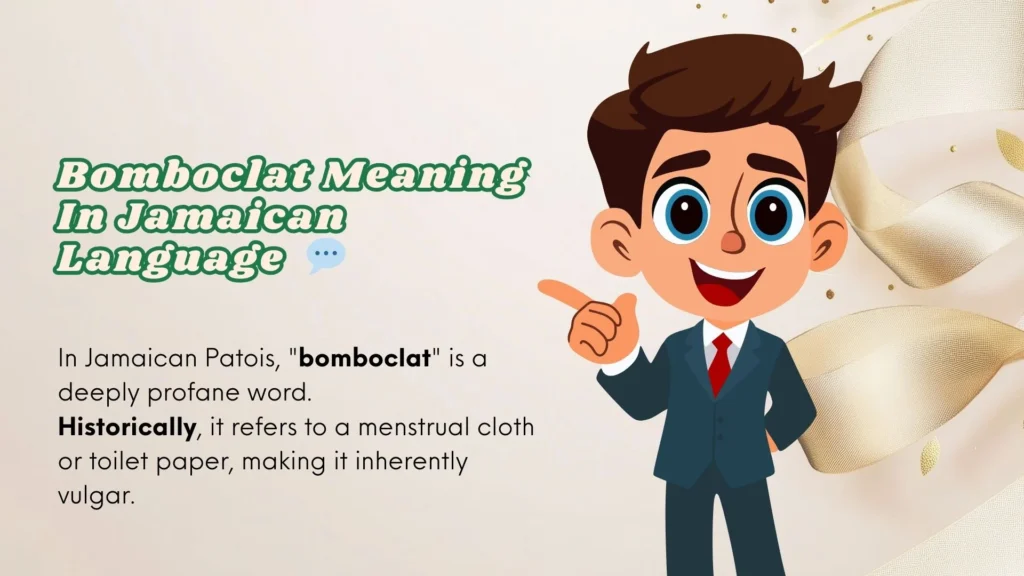
In Jamaican Patois, “bomboclat” is a deeply profane word.
Historically, it refers to a menstrual cloth or toilet paper, making it inherently vulgar.
Over time, it became a general-purpose curse word similar to how people use the F-word in English.
It’s used to express a wide range of emotions including anger, shock, annoyance, or excitement.
It’s considered highly offensive in Jamaica and should be used carefully and with cultural awareness.
Rasclat Bomboclat Meaning
“Rasclat” and “bomboclat” are both Jamaican swear words with similar meanings and origins—both refer to unsanitary clothes used for menstruation or hygiene.
When combined as “rasclat bomboclat”, the phrase becomes an even more intense expression of anger or insult.
This pairing is often shouted in moments of rage or extreme frustration and is among the most offensive phrases in Jamaican culture.
Though widely heard in reggae, dancehall, and internet memes, using these terms in Jamaica without understanding their weight can be seen as highly disrespectful.
Jamaican Bomboclat Meaning
The Jamaican meaning of “bomboclat” is rooted in Jamaican Patois and is considered a strong curse word.
The term originally referred to a menstrual cloth or toilet rag, making it inherently vulgar.
Over time, it evolved into a powerful expletive used to express anger, shock, or disbelief.
In Jamaica, it’s often used as a stand-alone outburst or inserted into sentences for emphasis.
Despite its use in pop culture, it’s considered offensive and taboo in everyday conversation among Jamaicans.
Bomboclat Meaning Twitter
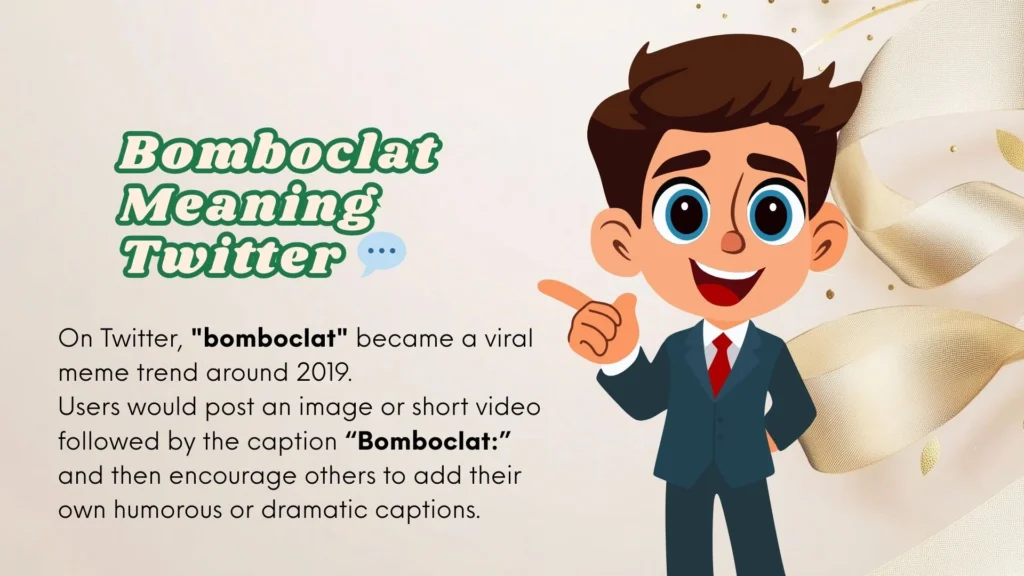
On Twitter, “bomboclat” became a viral meme trend around 2019.
Users would post an image or short video followed by the caption “Bomboclat:” and then encourage others to add their own humorous or dramatic captions.
In this context, “bomboclat” is used more playfully and has lost much of its original offensive tone, especially among international audiences.
It functions similarly to reaction memes, often to add spice, irony, or shock value to visual content.
Bomboclat Meaning Urban Dictionary
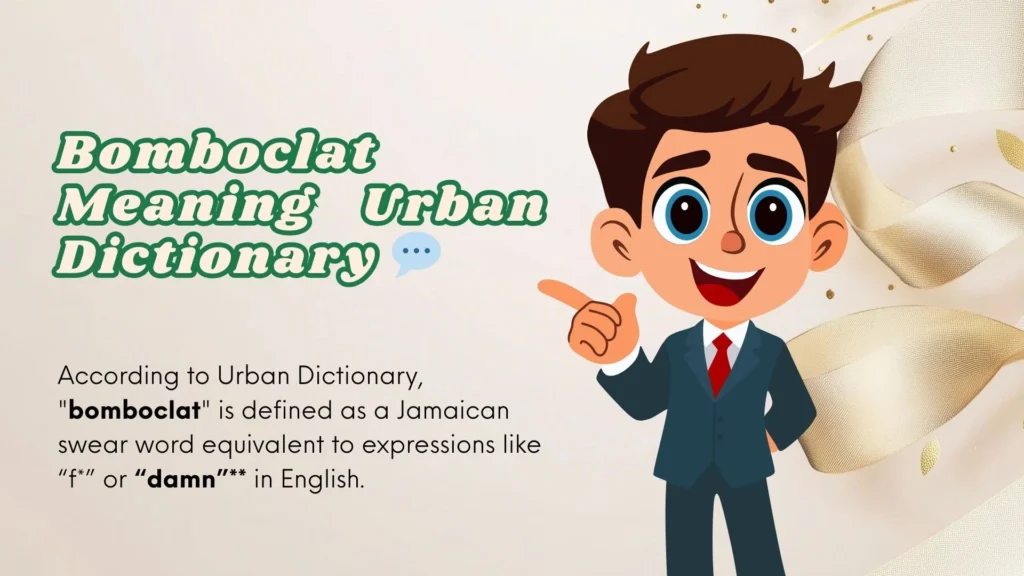
According to Urban Dictionary, “bomboclat” is defined as a Jamaican swear word equivalent to expressions like “f*” or “damn”** in English.
Entries also note its origin as a reference to a sanitary cloth, and how it is used to express strong emotion, such as anger, frustration, or surprise.
While Urban Dictionary reflects modern, often humorous interpretations of the word, it acknowledges the term’s cultural and linguistic roots in Jamaican Patois.
Bomboclat Meaning Jamaica
In Jamaica, “bomboclat” remains a highly offensive curse word, not something said casually in polite company.
It is deeply embedded in the culture as part of everyday expressive language, especially in heated arguments or during moments of intense emotion.
While it’s frequently heard in reggae and dancehall lyrics, using it as a foreigner without understanding its serious tone can be disrespectful or even provoke hostility.
It’s best understood as a cultural expression of deep emotion, not just slang.
Bomboclat Meaning Jamaican Patois
In Jamaican Patois, “bomboclat” (sometimes spelled “bumboclaat” or “bumboclat”) is derived from two parts:
- “bombo” – believed to relate to the buttocks
- “claat” – a patois word for “cloth” (often a rag or menstrual cloth)
Together, the term literally refers to a soiled sanitary cloth, which explains its vulgarity.
In speech, it’s used as an expletive, both as a standalone outburst or to add emotional intensity to a sentence. For example:
- “Wha di bomboclat yuh a do?” = What the hell are you doing?
It’s a vivid example of how Jamaican Patois uses everyday imagery to convey powerful emotional expressions.
Jamaican Bomboclat Meaning In English
In English, “Jamaican bomboclat” roughly translates to a strong curse word expressing anger, shock, or disbelief, similar to saying “What the hell?” or using the F-word.
The literal translation stems from “bumbo” (buttocks) and “claat” (cloth) — originally referencing a cloth used for hygiene or menstruation, which gives it a vulgar undertone.
Although English speakers may use it for comedic or dramatic effect, it remains a serious profanity in Jamaican culture.
Bomboclat Meaning Tiktok
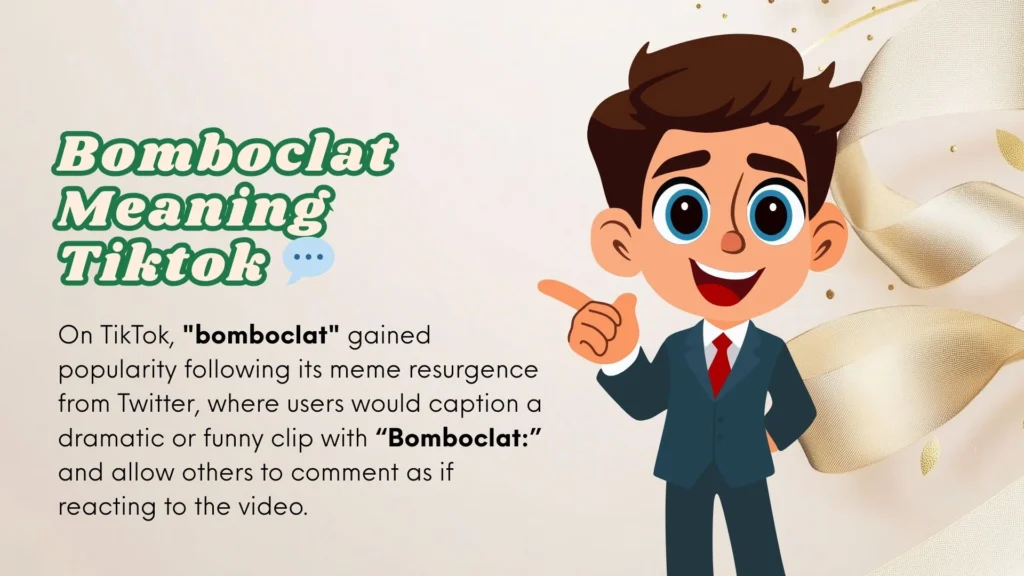
On TikTok, “bomboclat” gained popularity following its meme resurgence from Twitter, where users would caption a dramatic or funny clip with “Bomboclat:” and allow others to comment as if reacting to the video.
On TikTok, it’s used mostly humorously, often detached from its original vulgar meaning.
The word has become a slangy reaction tag, but its true meaning is often misunderstood by global users.
Despite its playful use online, it’s important to remember its offensive roots in Jamaican Patois.
Bomboclat Meaning Origin Jamaican Slang
The origin of “bomboclat” in Jamaican slang comes from the Caribbean creole language Patois, combining:
- “Bumbo” = a vulgar term related to the buttocks
- “Claat” = cloth (as in a rag, menstrual cloth, or toilet tissue)
So, “bomboclat” refers to a dirty or offensive cloth, which made it an extremely graphic and insulting word when it first appeared in speech.
Over time, it became a multi-purpose expletive in Jamaican culture—used to emphasize anger, surprise, or to insult someone.
It’s considered one of the strongest curse words in Jamaican slang.
Bomboclat Meaning Deutsch
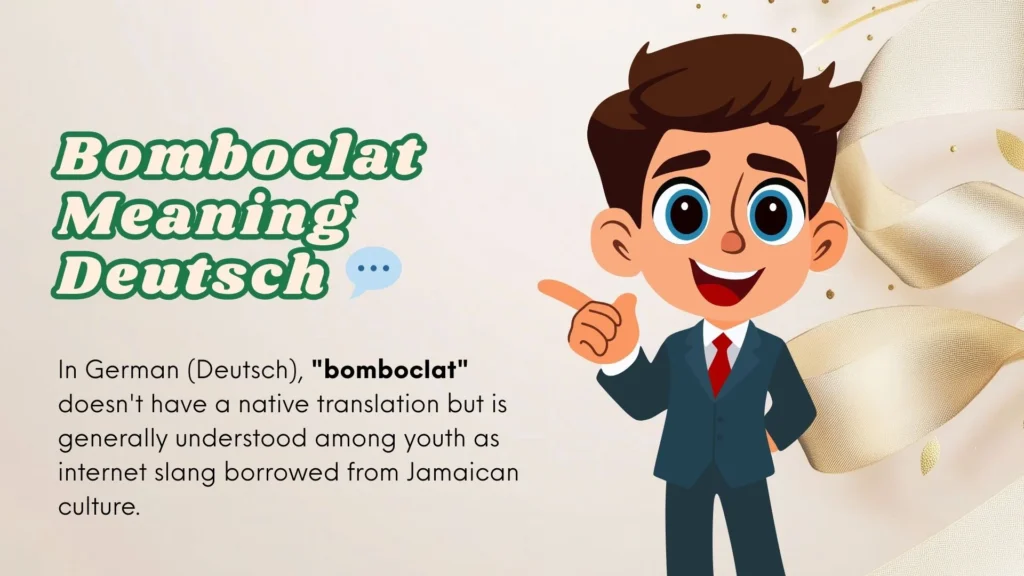
In German (Deutsch), “bomboclat” doesn’t have a native translation but is generally understood among youth as internet slang borrowed from Jamaican culture.
In Germany, it’s often used in memes or music without full awareness of its vulgar origin.
A rough German interpretation might be:
- “Verdammt nochmal!” (damn it!)
- “Was zum Teufel?” (what the hell?)
However, many German users use it just as a trendy or funny word, especially on platforms like TikTok and Twitter, not realizing it is an offensive word in its original context.
Jamaica Bomboclat Meaning
In Jamaica, “bomboclat” is one of the most aggressive and offensive swear words in the local dialect.
While it can be used for shock, humor, or in music (especially reggae and dancehall), it’s often seen as vulgar and is not appropriate in formal or respectful situations.
Depending on tone, it can either start a fight or end a conversation.
Despite its online popularity, in Jamaica, its use is taken seriously and usually reserved for heated arguments or emotional outbursts.
Jamaican Word Bomboclat Meaning
The Jamaican word “bomboclat” (also spelled bumboclaat) is a highly offensive curse word in Jamaican Patois. It originates from the combination of:
- “Bumbo” – a vulgar term for buttocks
- “Claat” – derived from the English word “cloth,” referring to menstrual cloth or toilet rag
Together, the word represents something filthy or disgraceful, and it is used as an expletive to express intense emotions like anger, surprise, or frustration.
In Jamaica, “bomboclat” is one of the strongest swear words, and using it in public can be deeply disrespectful if not used with cultural understanding.
Me Bomboclat Meaning
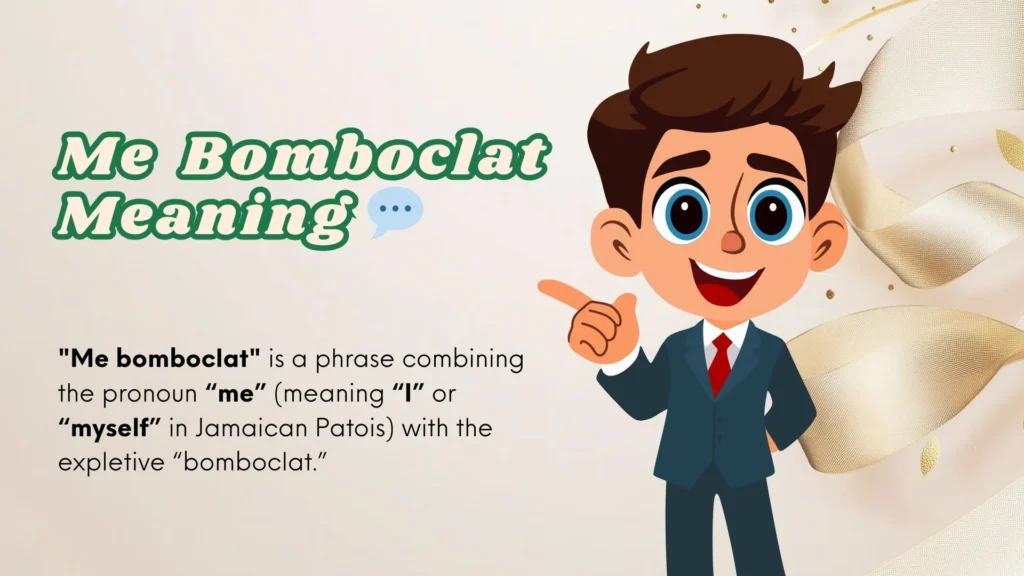
“Me bomboclat” is a phrase combining the pronoun “me” (meaning “I” or “myself” in Jamaican Patois) with the expletive “bomboclat.”
Depending on the context, it can carry meanings such as:
- “Me, damn it!”
- “I can’t believe it!”
- Or an aggressive self-reference during a confrontation, like: “You messin’ with me, bomboclat?”
It’s used for emphasis or emotional outburst and is not polite.
Although used casually on the internet, in Jamaica, saying “me bomboclat” is very provocative and could escalate conflict in verbal arguments.
Bomboclat Meaning En Español
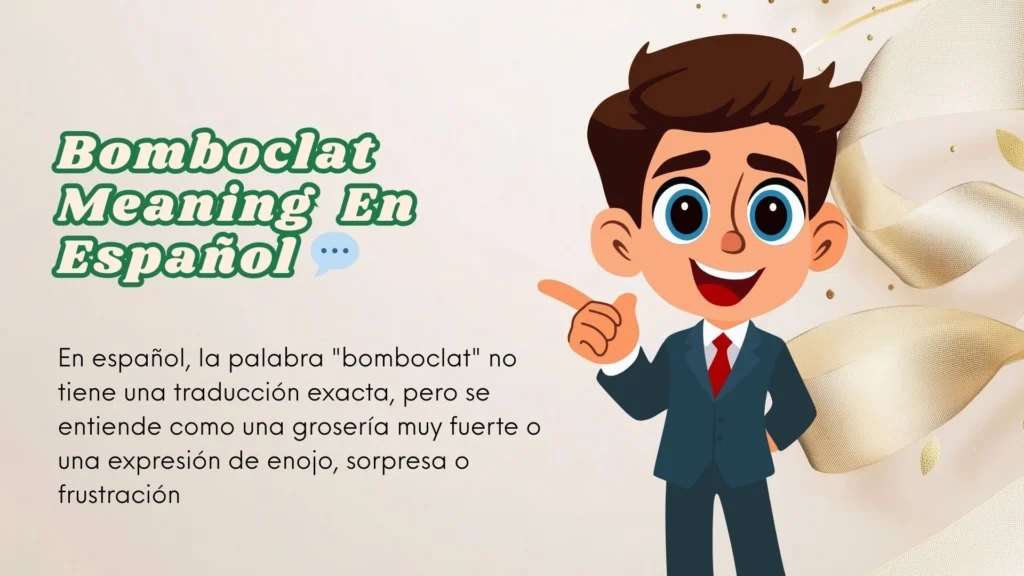
En español, la palabra “bomboclat” no tiene una traducción exacta, pero se entiende como una grosería muy fuerte o una expresión de enojo, sorpresa o frustración, similar a decir:
- “¡Maldita sea!”
- “¡Qué carajo!”
- “¡Joder!” (en España)
Originalmente viene del patuá jamaicano y hace referencia a un trapo sucio o una toalla menstrual, por lo tanto, tiene una connotación vulgar y ofensiva.
Aunque se ha viralizado en redes sociales, en su cultura de origen es una palabra muy fuerte que se debe usar con precaución.
Bomboclat Meaning In Spanish
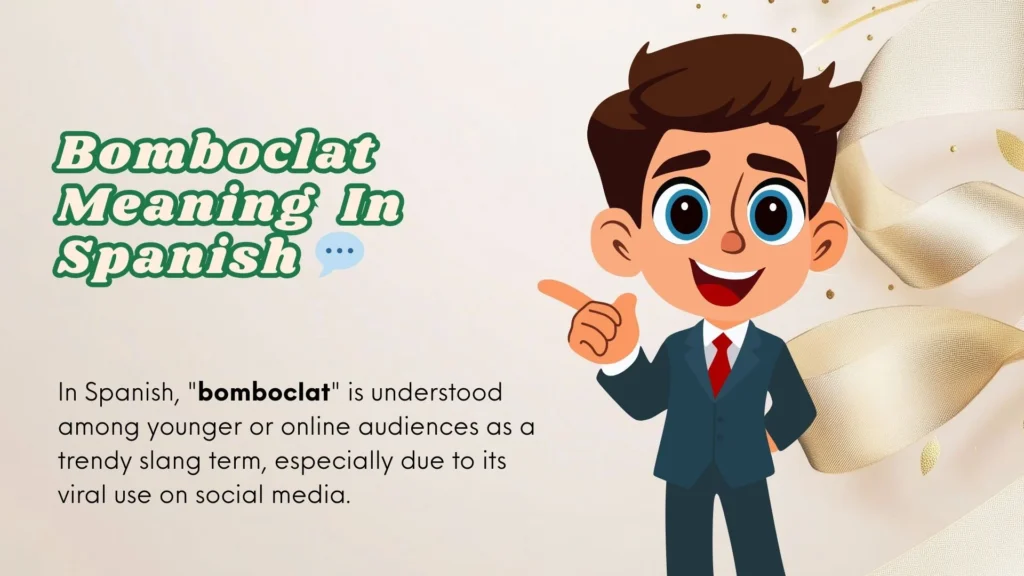
In Spanish, “bomboclat” is understood among younger or online audiences as a trendy slang term, especially due to its viral use on social media.
However, it does not exist in native Spanish vocabulary and retains its Jamaican Patois roots.
Translated into Spanish, it may be interpreted as:
- “¡Maldito!”
- “¡Qué demonios!”
- “¡Carajo!”
Despite these rough equivalents, it’s important to understand that “bomboclat” is much more offensive in Jamaica than these words are in Spanish.
It’s used as an aggressive insult or a shocking expression, not a casual word.
Is Bomboclat Offensive?
Yes—and no. Here’s the nuance.
- In Jamaican culture, bomboclat is a strong curse word, and using it casually—especially if you are not from the culture—can come across as culturally insensitive or even offensive.
- In internet culture, it’s largely lost its original vulgar meaning and is now used in a light-hearted or comedic tone.
However, context matters.
If you’re speaking in a formal setting, writing professionally, or addressing a culturally diverse audience, it’s better to use alternatives.
Why Did Bomboclat Go Viral?
The viral surge of “bomboclat” can be attributed to the social media shift toward visual storytelling.
Meme culture thrives on reaction images and viral formats. The “bomboclat” meme trend gave users a playful way to pair images or videos with their inner thoughts or sarcastic captions.
By late 2020, it had spread globally, and by 2025, it’s become a staple in online slang lexicons.
Stand For and Meaning in Text (2025 Version)
In modern 2025 usage, bomboclat in text stands for:
- “Say something!”
- “React to this!”
- “Caption this photo!”
- “This is wild/unbelievable!”
- “WTF?!”
This has no literal translation in standard English, but it functions phonetically and emotionally similar to expressive slang terms.
Think of it as a multi-purpose exclamation—tone and context decide its interpretation.
Top 10 Alternatives to Bomboclat (Polite, Casual, and Professional)
If you’re in a setting where you don’t want to risk sounding offensive or crude, here are 10 powerful and appropriate alternatives, sorted by tone and context:
1. “Caption This”
- Tone: Friendly, casual
- Use: When sharing an image or video for humorous responses
- Example:
“Caption this: My dog’s face when I said ‘vet.’ 🐶😂”
2. “Can Anyone Explain This?”
- Tone: Curious, neutral
- Use: When something is absurd, funny, or shocking
- Example:
“Can anyone explain this pigeon driving a toy car? 🚗🕊️”
3. “What in the world?”
- Tone: Surprised, casual
- Use: When reacting to unexpected or bizarre content
- Example:
“What in the world is happening here? 😂”
4. “React to this”
- Tone: Direct, universal
- Use: Simple call to action for engagement
- Example:
“React to this madness 😭👇”
5. “Say less…”
- Tone: Trendy, sarcastic
- Use: When an image says it all or needs no further explanation
- Example:
“When your paycheck hits and the rent is due: Say less…💸😩”
6. “This needs a caption”
- Tone: Engaging, friendly
- Use: Ideal for memes or group chats
- Example:
“This pic of my cat mid-jump needs a caption 😂”
7. “No words…”
- Tone: Expressive, modern
- Use: When an image is overwhelming or hilarious
- Example:
“No words… just vibes 🫣😂”
8. “Explain yourself 😭”
- Tone: Playful, meme-worthy
- Use: Often directed at someone in a funny or ridiculous situation
- Example:
“Found this in your room. Explain yourself 😭”
9. “I can’t even…”
- Tone: Gen Z, sarcastic
- Use: To express speechlessness or disbelief
- Example:
“I can’t even with this outfit. Who dressed you?! 😆”
10. “Someone please help me understand…”
- Tone: Semi-professional, mild sarcasm
- Use: Can be used in formal-informal hybrid settings like Slack or LinkedIn memes
- Example:
“Someone please help me understand how this became a trend…”
Contextual Usage Breakdown | How to Choose the Right Phrase
Choosing the right phrase depends on:
| Factor | Why It Matters | Best Choice |
|---|---|---|
| Audience | Friends vs. Colleagues | “Caption this,” “React to this” |
| Platform | TikTok vs. LinkedIn | “No words…” vs. “Help me understand…” |
| Cultural Sensitivity | Avoiding offense | Skip “bomboclat,” use alternatives |
| Formality | Casual vs. professional tone | “Explain yourself” is casual; “Can anyone explain?” is safe |
| Intent | Humor, sarcasm, or genuine surprise | Tailor based on tone of image or video |
Cultural Consideration | Slang Isn’t Universal
Slang is fluid and community-specific. What works in an online meme group may not work in your workplace or with an international audience. “Bomboclat” is a classic example of how context transforms meaning, but cultural respect remains essential.
Tip: When in doubt, go with universal humor and neutral language. It’s better to be understood than misunderstood.
Why Avoid Using Bomboclat in Professional Writing or Speech
Even though the internet has softened its original meaning, “bomboclat” still:
- May come across as offensive
- Has roots in profanity
- Isn’t universally understood
- Lacks clarity for non-social media users
It’s best to reserve it for private, informal group chats—not in job interviews, corporate communications, academic writing, or anywhere professionalism matters.
2025 Outlook | The Future of Viral Slang
As AI-generated content, voice memos, and video snippets continue to dominate communication, slang terms like “bomboclat” will continue to morph and fade.
In 2025, we’re already seeing newer expressions like “delulu,” “mid,” “rizz,” and “touch grass” replacing older memes.
Language thrives on novelty, so always ask:
“Does this word still serve my message—or is it just noise?”
Final Thoughts | Say It Better Than Bomboclat
Bomboclat is funny, meme-worthy, and part of internet history—but like all slang, it comes with caveats.
Use it when you know your audience.
Skip it when you need clarity, professionalism, or respect.
When in doubt, choose one of the 10 powerful alternatives above.

James Wilson is a puzzle aficionado with a flair for storytelling and a passion for problem-solving. His expertise in a wide range of puzzles, from crosswords to logic puzzles, shines through in his compelling and informative articles. James’ ability to make puzzling both fun and accessible makes him a beloved member of the Puzzlerpedia team.
